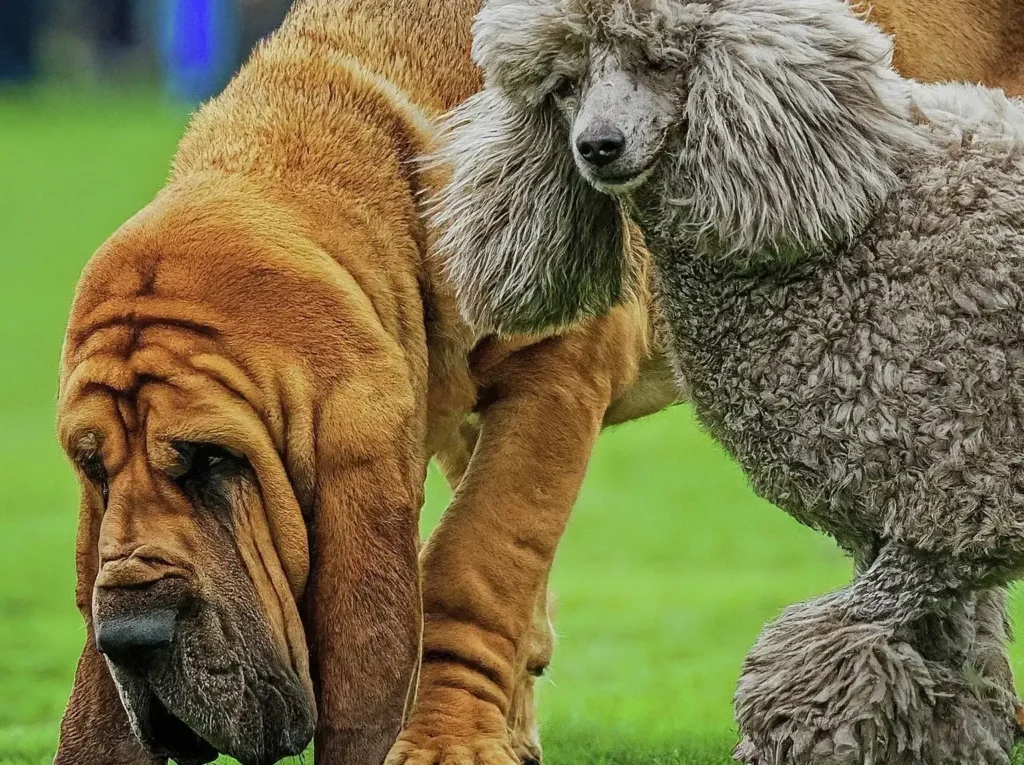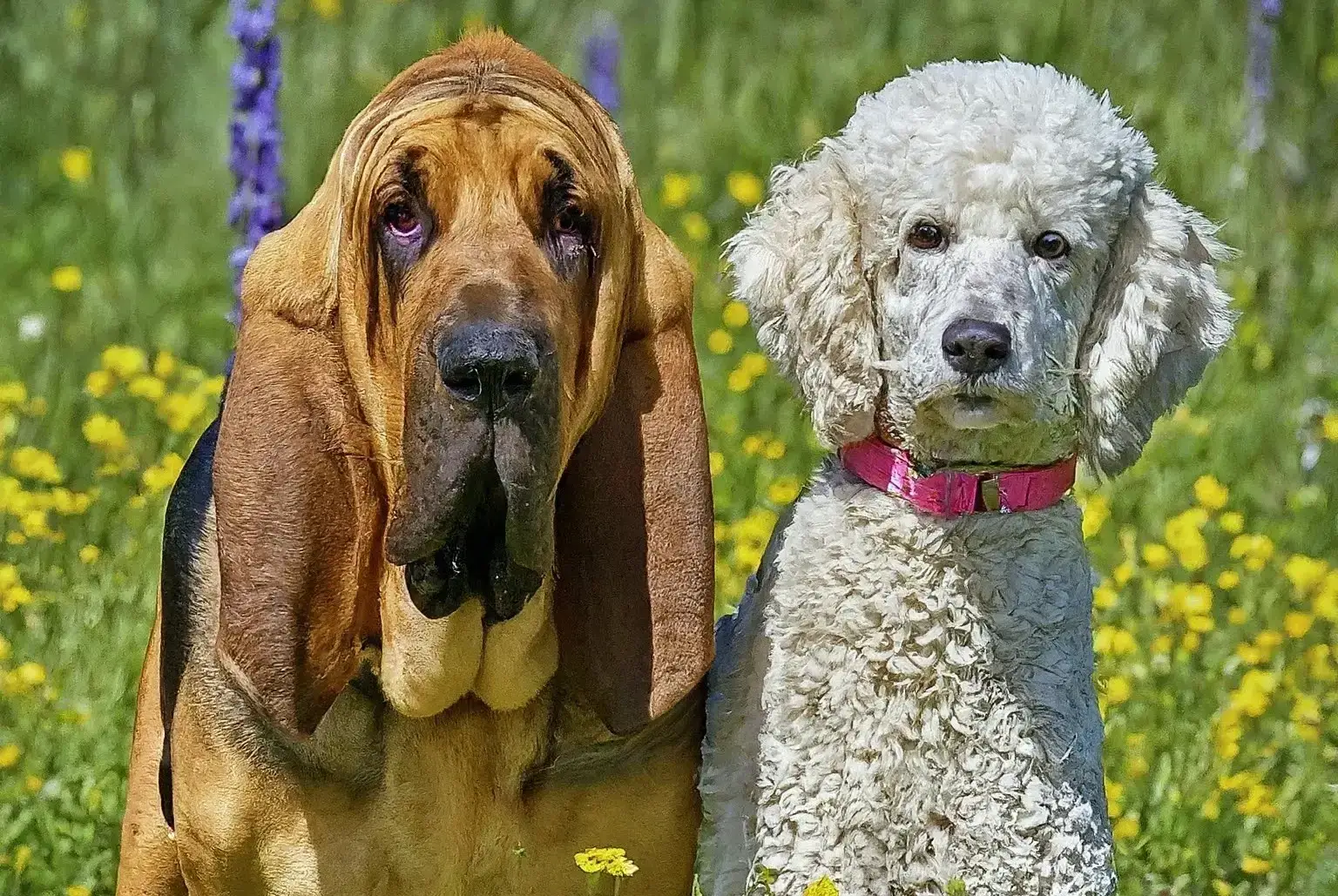The Bloodhound Poodle cross, affectionately known as the Bloodhoodle or Snooperdoodle, is a fascinating hybrid that combines the incredible scenting abilities of the Bloodhound with the intelligence and hypoallergenic coat of the Poodle. This mixed breed offers a delightful blend of personalities and traits, making them loyal and playful companions.
Understanding the Bloodhoodle
Origins: While the exact origin of the Bloodhoodle is unknown, designer dog breeds like this have gained popularity in recent decades.
Appearance: Bloodhoodles can vary significantly in looks. Some have the Bloodhound’s droopy face and long ears with the Poodle’s curly coat. Others have a more balanced mix of features. Coat colors range from black, brown, and tan to apricot and cream.
Size: Standard Poodles are typically used for this mix, resulting in a medium to large-sized dog, usually weighing between 40 and 70 pounds.
Temperament: Bloodhoodles are intelligent, affectionate, and playful. They inherit the Bloodhound’s strong tracking instincts and the Poodle’s love of learning. This mix can be stubborn at times but responds well to positive training.
Caring for Your Bloodhoodle
Exercise: These active dogs need regular walks and off-leash playtime to satisfy their sniffing instincts and burn off energy. Aim for at least an hour of daily exercise.
Grooming: Brush your Bloodhoodle regularly to prevent matting. The frequency and tools will depend on their coat type – those with curlier hair might need more frequent grooming.
Training: Start socialization and obedience training young. Consistency and positive reinforcement are essential, as their strong noses can lead to distraction.
Health: Bloodhoodles can inherit health issues from both parent breeds. Regular vet checkups are crucial for catching problems like hip dysplasia, bloat, and ear infections early.
Is a Bloodhoodle Right for You?
| Pros | Cons |
|---|---|
| Intelligent and trainable | Can be stubborn and require patience |
| Affectionate and loyal companions | Moderate to high exercise needs |
| Potentially hypoallergenic coat | Regular grooming necessary |
| Unique and interesting appearance | Predisposition to certain health conditions |
Life with a Bloodhoodle: Real Owner Stories

Meet Charlie, a Bloodhoodle owned by Sarah Jones in California. “Charlie is the ultimate cuddle buddy,” says Sarah, “but take him outside, and his nose takes over! We love going on hikes together; it’s amazing to see him pick up a scent and follow it.”
Another Bloodhoodle owner, David Miller from Texas, shares, “Gus, my Bloodhoodle, is full of personality. He’s goofy and loves to play fetch. Training can be a challenge, but his eagerness to please keeps me motivated.”
These are just a few examples of the joys Bloodhoodles can bring. Every dog is an individual, but these stories offer a glimpse into what life with a Bloodhoodle might be like.
Bloodhoodles: A Good Fit for Your Lifestyle?
Bloodhoodles can thrive in active households that can provide them with ample exercise, both physical and mental. Their intelligence makes them adaptable to various training styles, but their independent streak requires a patient and understanding owner.
Finding Your Bloodhoodle
Finding a Puppy: Seek out reputable breeders who prioritize health testing and ethical practices. Ask for references, and if possible, visit the breeder’s facility in person.
Adopting an Adult: Consider giving a rescued Bloodhoodle a second chance! Shelters and breed-specific rescues may have adult dogs looking for homes.
Commitment: Bloodhoodles need dedicated owners who can provide ample exercise, attention, and training for a happy, healthy life.
Puppy or Adult: Think about your lifestyle and experience. Puppies need extensive training, while adult dogs may have some basic skills but could come with their own set of needs.
Conclusion
The Bloodhoodle is a fascinating mix, perfect for active families seeking a playful, intelligent, and devoted companion. If you can provide ample exercise, consistent training, and understand their unique needs, a Bloodhoodle can be a wonderful addition to your life.
I hope you find this post helpful and informative. If Yes’ feel free to share it with your friends!
Frequently Asked Question
Can Bloodhoodles make good family pets?
With proper training and socialization, they can! Just be aware of their size and energy levels around small children.
Do Bloodhoodles tend to bark frequently?
They can be vocal, especially when excited or tracking scents.
What is the average lifespan of a Bloodhoodle?
They typically live between 10 and 13 years.
Do Bloodhoodles have other nicknames?
Yes, they’re sometimes called Snooperdoodles or Bloodles due to their heritage.
Are Bloodhoodles hypoallergenic?
They might be less likely to trigger allergies due to the Poodle influence, but it’s not a guarantee. Reactions vary by person.
How much exercise does a Bloodhoodle need?
These active dogs thrive with at least an hour of daily exercise and playtime.
Are Bloodhoodles easy to train?
They’re intelligent but can have a stubborn streak. Patient, consistent training with positive reinforcement works best.
Are there any common health concerns with Bloodhoodles?
They may be predisposed to health issues affecting either parent breed, such as hip dysplasia, bloat, ear infections, and eye problems.
How expensive are Bloodhoodle puppies?
Prices vary by breeder and location, but expect to spend between $800 and potentially over $2000.
Can Bloodhoodles live with other pets?
Absolutely! With proper socialization, most Bloodhoodles get along well with other dogs and cats.
Should I get a Bloodhoodle puppy or an adult?
Consider your lifestyle. Puppies need more intensive training, while adult dogs may have some basic skills but could come with their own set of needs.

